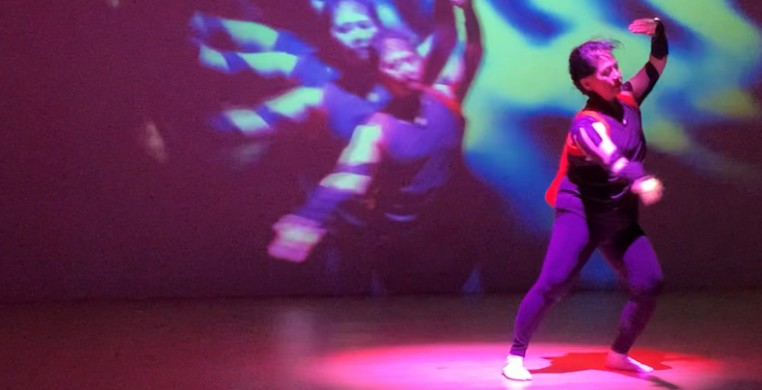“Black Hair E(m)urge: Beyond the Box 4.3” is an original dance, music and calligraphy collaboration presented virtually by Asian Improv aRts Midwest at Links Hall this past weekend.
Tuning into the virtual broadcast of its fourth annual installation in Links Hall’s “Beyond the Box” series, I found myself immediately transported into an auditory world of traditional Japanese string, percussion and vocal music and the visual designs of Japanese calligraphy and contemporary Asian portraiture.
The program, “Black Hair E(m)urge,” originally scheduled to be performed live last May, was cancelled by the pandemic and has reconfigured itself as a virtual production for this year.
Each of the three pieces merges historic Japanese storytelling conventions, inspired by the Kabuki and Noh theatre traditions, to combine with contemporary Asian and western aesthetics and technology.
Program curator and grandmaster Yoshinojo Fujima (aka Rika Lin) introduces each of the three pieces, structured to lead the audience in a continuum of meaning through metaphor and storytelling with gesture, rhythm, sound and duration.
Thematically, the program evolves from the traps that confine women to roles of servitude, longing and disillusionment to freedom and self-actualization. This is all deftly accomplished through the subtlety of traditional Japanese storytelling, delivering its message of liberation from the conventional societal constraints of women by using those very traditions of expression to tell that story.
The slow deliberateness of each gesture amplifies its impact, whether it is a gesture of frustration, fear, anger or hope. This is true for all three pieces, for puppet, puppeteer and dancer alike. It’s especially fascinating that the two puppet-theatre works on the progam align and perfectly complement the solo dance piece in theme, gestural design, and movement based on classical Japanese dance forms.
The puppets have seemingly fixed expressions on their carved and painted faces, but their faces magically open to reveal an expression of inner anguish, with the shadowy movement of the puppeteer operating in faceless anonymity around, behind and inside the puppet.
The first piece, puppeteer Ryugyoku Nishikawa's “Dragon Robe, River Bottom, Beautiful Jealousy,” derives from the Bunraku-style puppet theatre tradition and represents the program’s most conventional rendering of Japanese puppet theatre. The sound of waves and Japanese stringed instruments takes us to the sea, where two puppeteers operate the two characters: the Boatman and the Maiden. They enact the story of the Boatman’s broken contract that results in his transforming the Maiden into a dragon. She is punished and forever imprisoned in the body of this beast for her transgression of defiance against the Boatman.
Tom Lee is the puppeteer of the second piece, “Kurokami.” It begins with a disembodied hand holding a paintbrush and dipping it into black ink to create Japanese calligraphy on a white paper surface. We hear the sound of the paintbrush on paper, then gradually, the hand paints across the characters’ design in brushstrokes that cover the paper completely in black.
The sound of a Japanese flute and stringed instrument segues to a huge pile of black paper husks; a rustling of the paper, the husks begin to breathe; a living form begins to emerge, the puppet face of a woman appears. The shards are her black hair, a Japanese symbol of youth, strength, resilience and beauty. She sees a glowing object embedded in the nest that is her hair. Is it a birth? A promise?
The puppeteer wears the puppet and dances with her, as her. They are one in the physicality of the dance. She relishes her black hair and disappears into it.
Rika Lin describes her solo piece as a cinematic exploration of the bride, her rituals, the expectation of her ability to arrange flowers, perform the tea ceremony, and tend her garden. Her movement is constrained by the volumes of fabric that form her traditional kimono, her head enshrined in an ornamental black wig. A video image of a ghost dancer, her historic predecessors in traditional attire, haunts the background. The movement is slow, methodical and puppet-like in its deliberate gestures. Here, the solo dancer is in essence both her own puppet and puppeteer.
Drums introduce a transition from constraint to liberation. Lin re-appears in tights and a sleeveless top, red and blue bands of fabric around her arms and shoulders. Shedding her traditional costuming and “mask” of fixed facial expression, she reveals the truth of her interior life. The struggle to attain personal liberation climaxes in this final solo dance, with multiple images of herself lining up behind her, like butterfly wings emanating from her torso. The movement is bold and defiant—percussive—with arms swinging and sharp, angular gestures.
Lin’s culminating dance of triumph and liberation portends a bright future for Asian Improv aRts Midwest, thriving, persevering and breathing in new-found freedom in these hopefully waning days of COVID.

